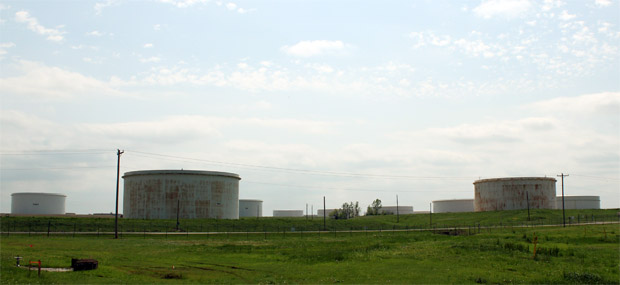
The oil hub in Cushing, Okla.
Joe Wertz / StateImpact Oklahoma


The oil hub in Cushing, Okla.
Joe Wertz / StateImpact Oklahoma
It’s hard to imagine a worse setting: A seemingly endless horizon of giant steel storage tanks holding 50 million barrels of crude oil, a spiderweb of pipelines, pumps, compressors and terminals, and a critical confluence of big corporations and international energy market money.
And a city of about 8,000 nearby.
Law enforcement has long feared the Cushing oil terminal would make an ideal target of terrorists, but what about a tornado? Just two weeks before the May 20 tornados devastated Moore, authorities held a worst-case-scenario F5 twister drill in Cushing.
The result: “Chaos,” reports EnergyWire’s Joel Kirkland.
Cushing hasn’t had an F5 tornado, but it’s not out of harm’s way: The tornado warnings issued on May 30 included the oil hub.
The drill started at 8 a.m. on May 7 and included every operator in Cushing, and hundreds of officials representing the petroleum industry, local, state and regional emergency authorities and teams from the FBI and Homeland Security, EnergyWire reports:
An instant response kicked into gear, as they had planned. On the morning of the drill, Cushing Fire Chief Chris Pixler set up a unified incident command post at a vocational school just outside town, where Cushing’s oil terminal workers take pipeline safety classes. Emergency response staging areas took shape around the prospect of injuries and fatalities. An industrial staging area organized top emergency managers from the oil companies.
“At the initial tornado strike, we’re already out of resources,” Pixler explained.
Search and rescue is the first priority. After that, authorities turn to the environmental and market mess:
Under the scenario, the state of Oklahoma’s resources for environmental cleanup and monitoring make their way to Cushing. But it could be 24-36 hours before the National Guard mobilizes, Pixler says.
Under these conditions, Pixler said the oil industry should be prepared for a three-day period, at a minimum, during which terminals won’t be operating normally.
Cushing’s consortium of emergency authorities, the Safety Alliance of Cushing, is waiting a final report on the drill detailing specific strengths and weaknesses, but EnergyWire reports that some insight has already been put into action:
On the morning of May 20 — with the drill still fresh in everyone’s memory — a real tornado barreled across the grasslands. [Shawn Roberts, a division manager for Plains All-American Pipeline] called to check on one of the larger oil storage terminals. They had already stopped transferring petroleum among pipelines and tanks.